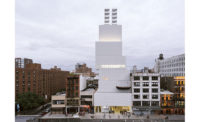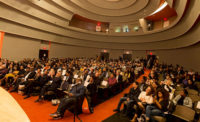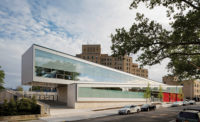This year will see the opening of New York’s 730,000-square-foot energy-efficient police academy complex by Perkins + Will. Joining it in the fall, Staten Island will welcome an elegant, cantilevered police station for the 121st precinct, by Rafael Viñoly Architects. And the same borough will soon cut the ribbon on a 184,000-square-foot, glass-walled courthouse from Ennead Architects.
Yet these gleaming projects, and others like them around the country, in many ways gloss over the reality of the justice sector of the architecture industry, which is struggling after being hit with a double whammy. Because of the recession, public funding has evaporated, designers say, and falling crime rates have meant fewer criminals, which in turn has decreased demand for new space.
“It’s not like what it was,” says Ken Ricci, a principal of Ricci Greene Associates, a 25-year-old firm based in New York that designs many prisons, which make up the bulk of most justice-focused practices. A widespread push by courts to keep lower-level offenders out of the judicial system has also contributed to the drop-off, he adds.
Overall, in 2011, 6.98 million people were incarcerated in this country, down 1.4 percent from 2010, which continued a three-year decline, according to the federal Bureau of Justice Statistics. Besides, in an austere age, cities, counties, and states are commissioning studies rather than designs, says Lori Coppenrath, a designer with Seattle-based DLR Group: “Everybody is trying to figure out what they need before moving forward.” And the effects have been felt. Over the last few years, large firms like AECOM have pared their justice practices, industry sources say, while smaller firms active in the sector have shuttered outright, like Durrant Group of Dubuque, Iowa, in spring 2012.
But the sector hasn’t come to a complete halt, and where there is work, it is more humane. After years of discussions, Kailua-Kona, Hawaii, has finally decided to go ahead with a $70 million state court that DLR will design, says Coppenrath. Similarly, Ricci, of Ricci Greene, recently ramped up hiring, as his staff has grown to 31 employees, from 24 in the recession. Prisons may be less plentiful, but they are still necessary, though “they need to be kinder, they need to be smaller, they need to be smarter, and they need to be greener,” says Ricci. His Van Cise-Simonet Detention Center, which opened in Denver in 2010 is a 500-bed facility has outdoor areas next to living spaces, so exercise can be more convenient. The five-story complex is also not located on the outskirts of town, like in the past, but in an urban, easy-to-reach setting.
The next generation of prisons also has little razor-wire, like the 700-bed facility from HOK being constructed in downtown Redwood City, California. In fact, its three-level façade is clad with porcelain tile, like an office building. “Anybody passing by would be hard-pressed to know it’s a jail,” says Jeff Goodale, who heads the justice practice at HOK, which seems to be bucking a trend: its has doubled its volume of justice projects since 2009, to $27 million from $12 million, Goodale says, while boosting its employees to 30 from 24.
But it also may be smart to focus on California. Under its 2011 “realignment” plan, non-violent offenders are steered to local correctional facilities instead of overcrowded state prisons, and the state is spending about $4 billion to prepare those local facilities.
And there’s pressure to change the status quo from within designers’ ranks. Designer Raphael Sperry is president of Architects, Designers, Planners for Social Responsibility, a 50-member advocacy group that has spent years trying to convince architects to refuse prison commissions if they include solitary confinement spaces. Moreover, he’s asking the American Institute of Architects (AIA) to amend its code of ethics so as to prohibit those kinds of jobs, calling his cause a critical human rights issue. As Sperry puts it, “When you walk into a building, it should say, ‘We are not planning to torture or degrade you.’”






Post a comment to this article
Report Abusive Comment